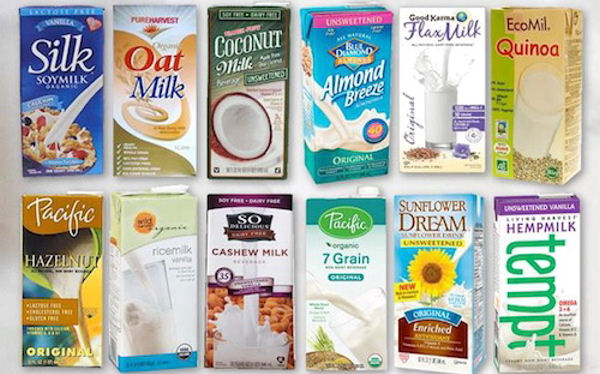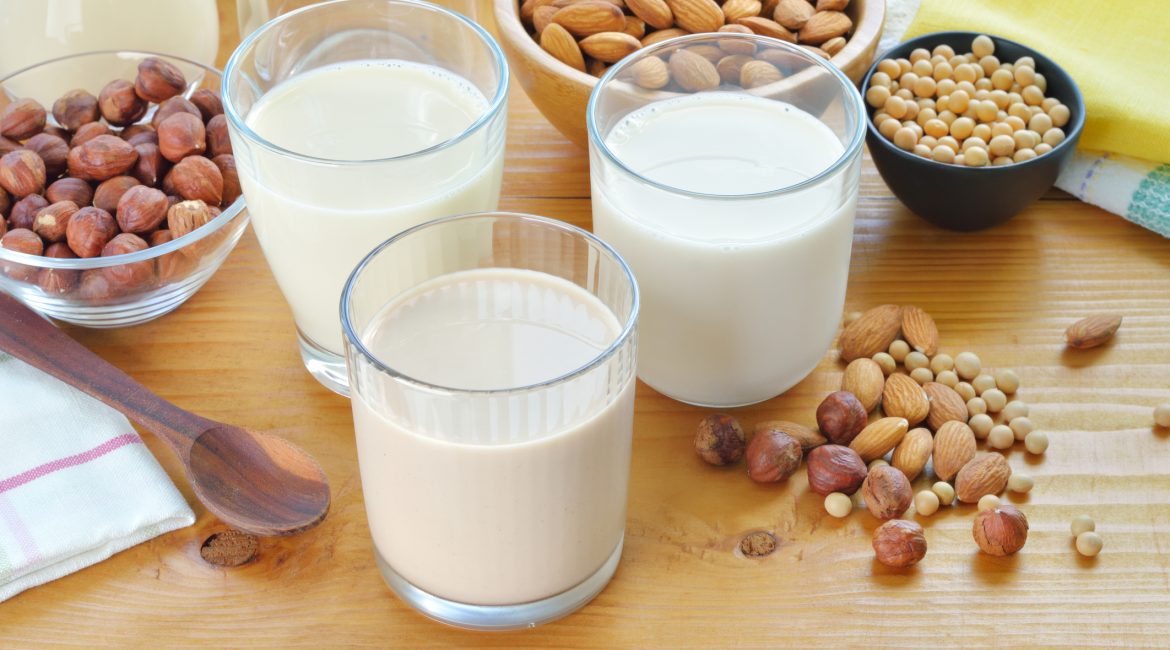
I was recently approached by a family friend who rather forcibly challenged me on how I could possibly criticise processed foods (he was specifically referring to olive oil) when the plant milks that “you vegans” drink are also processed. Firstly, I pointed out that I am not a vegan and, secondly, that the biggest issue here isn’t the word “processed” in relation to these two items (olive oil and plant milk) but the word “oil”.
There are good reasons not, and I repeat NOT, to consume oils, but that’s not the issue in question. His concern that the hemp milk he saw next to my breakfast berries and muesli was processed.
This got me to thinking that there are probably a lot of people out there who are unsure whether plant milks are ultra-processed, slightly processed or not really classed as processed foods at all. So here’s the inside line on plant milks:
Did you know you can get all these:
- Hemp milk
- Soy milk
- Almond milk
- Hazelnut milk
- Oat milk
- Rice milk
- Cashew milk
- Flax milk
- Macadamia Milk
- Brazil nut milk
- Quinoa Milk
You can, of course, get coconut milk and even almond-coconut milk, but I don’t suggest these because of the >20% saturated fat content and because their flavour is stronger than most people want in their cuppa or on their cereals.
The ideal plant milk is the one with minimal processing, minimal additives and as close as possible to its original whole food nature. And, of course, use organic wherever possible.
Simply put, this generally means home-made is best. But how? Very simple:
Blog Contents
Hemp Milk
You can soak hulled hemp seeds (sometimes called hemp hearts) if you want, from 2 hours to overnight. However, this is not necessary. It’s also possible to use non-hulled hemp seeds if you don’t mind having the milk darker and a bit chewier – it would certainly be closer to the whole food in this case. Try it and see which you prefer.
In a blender, combine the 80-100 grams (0.5 cup) of your chosen type of hemp seed with around 450 ml (2 cups) of water. Blend for at least 2 minutes or until you are happy that it is well blended.
You either can get a specific “nut milk bag“, use an ordinary ;large sieve or, as I do, just drink it with some of the bit in it. If you do strain it, the remaining solids can be used in all sorts of recipes, depending on the type of seed or nut used.
Store in a sealed container of your choice. Serve.
You can keep it refrigerated for about 5 days. Shake well before using.
I think this is both the simplest and the most wholesome (that is, closest to the whole food) way of doing this. You will find that most of the recipes for all other plant milks are made in a pretty similar way.
There are lots of videos and recipes for this and other plant milks, but I thought you might like to see just how easy it is to make by someone who doesn’t use anything but the above two ingredients – that is, no salt, sugar, vanilla essence, etc.
Soy, Almond and Chocolate-Hazelnut Milks
Mic the Vegan is a fun guy and has pretty much the same philosophy as I do on all things nutrition. I am going to leave it to him to explain the soy, almond and chocolate-hazelnut milks to you. Of course, you can make hazelnut milk without the added cocoa powder and dates if you want it unsweetened and “unchocolatey”…
Here are his recipes:
Soy Milk
Ingredients:
- 1/2 cup dry soy beans
- 4.5 cups water (4 for extra creamy)
- If sweet – 3-4 dates (I tend to use medjool dates – soft and plump – and pitted, of course)
- If sweet – 1.5 teaspoons of vanilla extract
Almond Milk
Ingredients:
- 1/2 cup of almonds
- 2 cups water
- If sweet – 3 dates
- If sweet – 1 teaspoon vanilla extract
Chocolate-Hazelnut Milk:
Ingredients:
- 1/2 cup hazelnuts
- 2 cups water
- 3 dates
- 1 tablespoon (unsweetened) cocoa powder
Oat Milk
Ingredients:
- 1 cup / 150 grams rolled oats (not instant)
- 3 cups (770 ml) water
- If sweet – 2-4 dates
I have found that if you don’t mind having bits in your milk, then you don’t need to bother pre-soaking oats (or any other nuts/seeds/grains used in plant milk recipes), since the solids that remain in the milk will swell and release their flavour during the time that the milk is stored. However, if you want a really “filtered” final milk, then it is worth soaking for several hours or overnight, as well as sieving the blended results.
When I make most plant milks (excluding soy, which needs soaking and rice, which needs pre-cooking), I don’t bother soaking. I even sometime leave all the blended mixture in the final milk, simply give it a good shake before using, and enjoy the fact that I am eating the whole food with just a bit of water added. It’s up to personal taste, as are most things in life.
Here is a nice video that shows just how easy oat milk is to make without the need for soaking (and he suggests you keep the solids for adding to a porridge:
Rice Milk
Again, really simple.
- 1 cup / 150 grams cooked brown/red/wild rice
- 3 cups (770 ml) water
- If sweet – 2-4 dates
- 1 tsp cinnamon
Cashew milk
Some people soak and some don’t. Experiment and decide for yourself which you prefer.
Here’s one recipe (again, I do not recommend the salt):
- 1 cup (150 grams) soaked cashews
- 4 cups (approx. 1 litre) water
- If sweet – 1/2 tsp vanilla essence
- If sweet – 3-4 dates
And here’s a video that will give you a good idea of how easy it is (she makes a vanilla-cashew milk):
Flax milk
Ingredients:
- 1/2 (120 grams) cup flax seeds
- 4 1/2 cups (approx. 1 litre) water
Directions:
- Blend flax seeds and water in a blender on high for 1 minute; allow to rest for 2 minutes
- Blend again on high for 1 minute; allow to rest for 5 minutes
- Blend again for 30 seconds
- Pour milk through a nut bag or a strainer (possibly lined with cheesecloth or clean tea towel) into glass korken/kilner jar or any container of your choice. TIP: I wash out and reuse the 1 litre plant milk cartons that commercially-produce plant milks come in – use a funnel to get milks into the narrow top
- Press solids with back of a spoon to extract liquid
- Gather cheesecloth/tea towel around solids, twist and squeeze to extract all the liquid
- Keep the solids to use in other recipes
Another slight variation of the recipe:
Macadamia Milk
Ingredients:
- 1 cup raw macadamia nuts
- 3-4 cups (750 ml – 1 litre) water
- Pinch cinnamon (optional)
- If sweet – 3-4 dates
- If sweet – 1 tsp vanilla bean paste/essence
Method:
- Blend all ingredients for 2-3 minutes or until smooth
- Either use immediately or refrigerate for later
Brazil nut milk
Dr Greger warns about having any more than 4 Brazil nuts per month! At this level, they are thought to be effective at lowering LDL cholesterol, but at higher levels (say 8 nuts per month) they appear to have the reverse effect. Odd, eh? Also. the high selenium concentration of Brazil nuts is thought to increase the risk of liver and kidney toxicity. So, while they are lovely nuts, I would recommend that this milk is used sparingly, if at all. That’s why I am omitting any recipes or videos on it, since you would have to use more than 4 nuts to get sufficient quantity of usable milk.
Okay the last of the plant milks that I am going to cover in quinoa. Of course, there are more nuts/seeds/grains that can be made into milk, but I have to stop somewhere… If you try one that I have not covered, let me know how it goes.
Quinoa Milk
Ingredients:
- 1 cup (240 grams) cooked quinoa
- 3 cups (750 ml) water
- If sweet – 4 dates
- 1/4 tsp cinnamon (optional)
Instructions:
- Cook quinoa according to package directions
- Blend the quinoa with the water until well blended and almost smooth
- Strain the blended quinoa mixture using a cheesecloth or a strainer
- Pour the quinoa milk in a blender and blend with the dates and cinnamon
- Refrigerate the quinoa milk in a sealed container for up to 5 days

Finally, I hope you get the idea by now that making your own plant milk is:
- cost-effective
- as healthy as it is possible to make it
- can contain the whole nut/grain/seed if you wish to make it this way
- contains no additives (for instance, these are the ingredients of Waitrose’s Hemp Milk – Water, Hemp Extract (3%), Grape Juice Extract Concentrate, Tricalcium Phosphate, Emulsifier (Sucrose Ester), Stabiliser (Xanthan Gum), Natural Flavouring (Vanilla), Sea Salt, Vitamin D2)
Happy milking!
References
E Colpo, C D de Avila Vilanova, L G B Reetz, M M M F Duarte, I L G Farias, E I Muller, A L H Muller, E M M Flores, R Wagner, J B T da Rocha. J Nutr Metab 2013 2013:653185. A single consumption of high amounts of the Brazil nuts improves lipid profile of healthy volunteers.